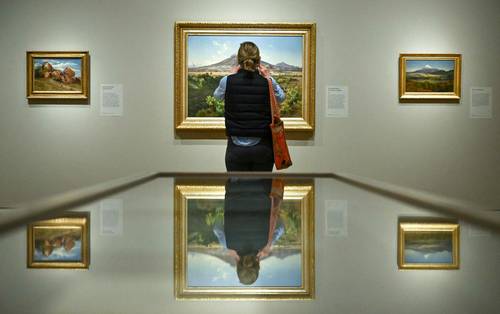José María Velasco, The most important artist of the nineteenth century in Mexico
according to the National Gallery of London
London. Gabriele Finaldi, director of the London National Gallery, presented José María Velasco as The most important artist of the nineteenth century in Mexico
On the occasion of the opening of the first exhibition dedicated in that country to the Mexican landscape, which will remain until August 17.
The sample has broken with the mold of the Angulafera, that this small room had already challenged when granting a space to Australian and American artists of the nineteenth century. Therefore, this foray into the Latin American world of the same period is especially relevant, which establishes a global, but safe dialogue.
Velasco worked in the same years as the impressionists, a family movement for the general public that frequents the museum. In addition, Mexico, after becoming independent from Spain, became a country of great commercial and cultural interest for the United Kingdom.
The bridge to romantic painters, explorers and British archaeologists was natural. His expeditions allowed to interpret and disseminate the first views of the Mexican landscapes and archeology that the London public could know.
A pioneer in this regard was William Bullock, naturalist, painter and collector, who arrived in Mexico in January 1823, when the country had just achieved its independence and crossed great political instability.
Bullock had opened in 1812 the most popular London gallery on Piccadilly Street. In April 1824 – a month before the National Gallery opened its doors – organized what was probably the first public exhibition of Mexican art, both old and contemporary. The sample included archaeological pieces that are part of the British Museum’s collection today. In addition, he published the book Six Months and Travels in Mexico (1824), which sold quickly and as hot bread.
His son, at the request of the Mexican government, installed his easel on the roof of the cathedral to make panoramic sketches of the Valley of Mexico, dominated to the background by the volcanoes Popocatepetl and Iztaccíhuatl. Subsequently, these sketches shape an immense continuous painting divided into two parts, with a total extension of 250 square meters, as Michael P. Costloe clarified in a study.
He Panorama of Mexico It was a prolonged success. It was exhibited in London, first in the leiceter Square diorama (1825-1826), located a few minutes from the National Gallery, and again in 1853. Costloe cites journalistic reviews that highlight the public’s admiration for Valleys and lakes, snow -covered volcanoes and the glorious surrounding landscape
. Later, the work Itineró in the United States between 1828 and 1836.
Another relevant artist was Daniel Thomas Egerton, who lived in Tacubaya and died murdered, along with his English lover, at the hands of bandits. Egerton presented on several occasions in the Royal Society of British artists and, in 1837 he presented his masterpiece, The Valley of Mexico. In 1840 – Año from the birth of Velasco – published the album of lithographs Egerton’s Views in Mexico.
Then the famous book by John Lloyd Stephens saw the light, Incidents of Travel in Central America, Chiapas and Yucatan (1841), illustrated with drawings by British Frederick Catherwood. These images inspired Alfred Maudslay, considered the Father of Mayan archeology
to explore the region.
Between 1881 and 1894, Maudslay made expeditions using avant -garde photographic technology and interested in the conservation of Mayan inscriptions. It produced plaster molds with the intention of melting in Metal in London. Currently, these pieces have been digitized and are accessible to the public thanks to the Google Mayan project of the British Museum, an institution that protects it. Its legacy includes 800 negatives in glass plate.
The exhibition highlights the early collaboration of Velasco with the National Museum of History through two oils of Teotihuacan (1878) and The baths of Nezahualcóyotl, made before the formal exploration of the site. His link with the museum, where he worked from 1880 until his death, evidences the connection between his work and the foreign interest in Mexico during the archaeological boom of the Porfiriato, reinforcing the historical ties with Great Britain.
